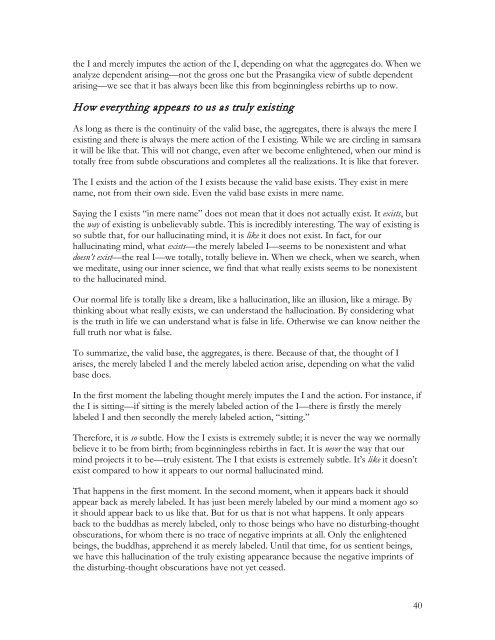Lama Zopa Rinpoche
55OTzl52A
55OTzl52A
Create successful ePaper yourself
Turn your PDF publications into a flip-book with our unique Google optimized e-Paper software.
the I and merely imputes the action of the I, depending on what the aggregates do. When we<br />
analyze dependent arising—not the gross one but the Prasangika view of subtle dependent<br />
arising—we see that it has always been like this from beginningless rebirths up to now.<br />
How everything appears to us as truly existing<br />
As long as there is the continuity of the valid base, the aggregates, there is always the mere I<br />
existing and there is always the mere action of the I existing. While we are circling in samsara<br />
it will be like that. This will not change, even after we become enlightened, when our mind is<br />
totally free from subtle obscurations and completes all the realizations. It is like that forever.<br />
The I exists and the action of the I exists because the valid base exists. They exist in mere<br />
name, not from their own side. Even the valid base exists in mere name.<br />
Saying the I exists “in mere name” does not mean that it does not actually exist. It exists, but<br />
the way of existing is unbelievably subtle. This is incredibly interesting. The way of existing is<br />
so subtle that, for our hallucinating mind, it is like it does not exist. In fact, for our<br />
hallucinating mind, what exists—the merely labeled I—seems to be nonexistent and what<br />
doesn’t exist—the real I—we totally, totally believe in. When we check, when we search, when<br />
we meditate, using our inner science, we find that what really exists seems to be nonexistent<br />
to the hallucinated mind.<br />
Our normal life is totally like a dream, like a hallucination, like an illusion, like a mirage. By<br />
thinking about what really exists, we can understand the hallucination. By considering what<br />
is the truth in life we can understand what is false in life. Otherwise we can know neither the<br />
full truth nor what is false.<br />
To summarize, the valid base, the aggregates, is there. Because of that, the thought of I<br />
arises, the merely labeled I and the merely labeled action arise, depending on what the valid<br />
base does.<br />
In the first moment the labeling thought merely imputes the I and the action. For instance, if<br />
the I is sitting—if sitting is the merely labeled action of the I—there is firstly the merely<br />
labeled I and then secondly the merely labeled action, “sitting.”<br />
Therefore, it is so subtle. How the I exists is extremely subtle; it is never the way we normally<br />
believe it to be from birth; from beginningless rebirths in fact. It is never the way that our<br />
mind projects it to be—truly existent. The I that exists is extremely subtle. It’s like it doesn’t<br />
exist compared to how it appears to our normal hallucinated mind.<br />
That happens in the first moment. In the second moment, when it appears back it should<br />
appear back as merely labeled. It has just been merely labeled by our mind a moment ago so<br />
it should appear back to us like that. But for us that is not what happens. It only appears<br />
back to the buddhas as merely labeled, only to those beings who have no disturbing-thought<br />
obscurations, for whom there is no trace of negative imprints at all. Only the enlightened<br />
beings, the buddhas, apprehend it as merely labeled. Until that time, for us sentient beings,<br />
we have this hallucination of the truly existing appearance because the negative imprints of<br />
the disturbing-thought obscurations have not yet ceased.<br />
40


